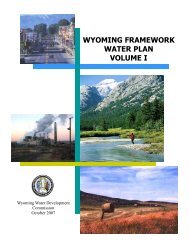population estimates for humpback chub - Upper Colorado River ...
population estimates for humpback chub - Upper Colorado River ...
population estimates for humpback chub - Upper Colorado River ...
Create successful ePaper yourself
Turn your PDF publications into a flip-book with our unique Google optimized e-Paper software.
Movement<br />
Humpback <strong>chub</strong> have previously been documented to move less than roundtail <strong>chub</strong> and other<br />
<strong>Colorado</strong> <strong>River</strong> fishes (Valdez and Clemmer 1982, Archer et al. 1985, Kaeding et al. 1990, Valdez<br />
and Ryel 1995, Chart and Lentsch 2000). Archer et al. (1985) found in Black Rocks that roundtail<br />
<strong>chub</strong> moved more than <strong>humpback</strong> <strong>chub</strong>. Valdez and Ryel (1995) later supported that finding by<br />
stating that <strong>humpback</strong> <strong>chub</strong> moved substantially less than other <strong>Colorado</strong> <strong>River</strong> fishes. Valdez and<br />
Clemmer (1982) recaptured seven <strong>humpback</strong> <strong>chub</strong> in Desolation/Gray canyons that had originally<br />
been captured in the same locations. Chart and Lentsch (2000) further supported this finding by<br />
reporting the recapture of nine <strong>chub</strong> at the original capture locations in Desolation/Gray canyons.<br />
In Westwater Canyon, little movement of <strong>humpback</strong> <strong>chub</strong> and roundtail <strong>chub</strong> has been documented<br />
in the past, but the limited data indicates <strong>humpback</strong> <strong>chub</strong> move more than roundtail <strong>chub</strong> (Chart and<br />
Lentsch 1999). A substantially larger dataset of recaptured <strong>humpback</strong> <strong>chub</strong> and roundtail <strong>chub</strong> from<br />
this study indicates similar levels of movement: 20% of <strong>humpback</strong> <strong>chub</strong> were recaptured in a<br />
different location; 11% of roundtail <strong>chub</strong> were recaptured in a different location. However, from<br />
1998 to 2000, there was a substantially higher rate of movement by <strong>humpback</strong> <strong>chub</strong> among all three<br />
sites. All roundtail <strong>chub</strong> movements from 1998 to 2000 were between Cougar Bar and one of the<br />
other two sites, while, in addition, Chart and Lentsch (1999) observed limited movement from<br />
Miners Cabin to Hades Bar.<br />
As long-term recaptures increased in 1999 and 2000 with a smaller period of time between capture<br />
occasions <strong>for</strong> an individual, there was less evidence of movement in recaptured individuals. In 1998,<br />
the number of recaptured individuals from 1997 was relatively low. Long-term recaptures were<br />
more representative of <strong>humpback</strong> <strong>chub</strong> that had been captured from 1992 to 1996, and these<br />
individuals exhibited more movement among sites within Westwater Canyon. Thus, short-term site<br />
fidelity is supported by the data. However, once <strong>humpback</strong> <strong>chub</strong> move to a new location, short-term<br />
site fidelity may be re-established <strong>for</strong> that area. A radiotelemetry component added to future<br />
<strong>population</strong> <strong>estimates</strong> may provide insight to within and among site movements of <strong>humpback</strong> <strong>chub</strong> in<br />
Westwater Canyon.<br />
Movement of <strong>humpback</strong> <strong>chub</strong> and roundtail <strong>chub</strong> between Black Rocks and Westwater Canyon has<br />
been previously documented (Chart and Lentsch 1999; McAda 2003). The capture of three<br />
<strong>humpback</strong> <strong>chub</strong> and three roundtail <strong>chub</strong> from 1998 to 2000 in Westwater Canyon that were<br />
originally tagged in Black Rocks supports the theory of continued exchange between these two<br />
areas. Furthermore, McAda (2003) documented 14 <strong>humpback</strong> <strong>chub</strong> that had originally been tagged<br />
in Westwater Canyon prior to 1998 that were recaptured in Black Rocks from 1998 to 2000. This<br />
migration of approximately 10.5 miles between Black Rocks and Westwater Canyon violates the<br />
assumption of closure associated with the models being used <strong>for</strong> <strong>population</strong> <strong>estimates</strong>. The<br />
frequency of movement between the two canyon areas is similar to that between areas within<br />
Westwater Canyon and exceeds the one migrant per generation required to prevent genetic<br />
differentiation (Mills and Allendorf 1996). It may be more appropriate to consider Black<br />
Rocks/Westwater Canyon <strong>humpback</strong> <strong>chub</strong> a single <strong>population</strong> and analyze it as such.<br />
11
















